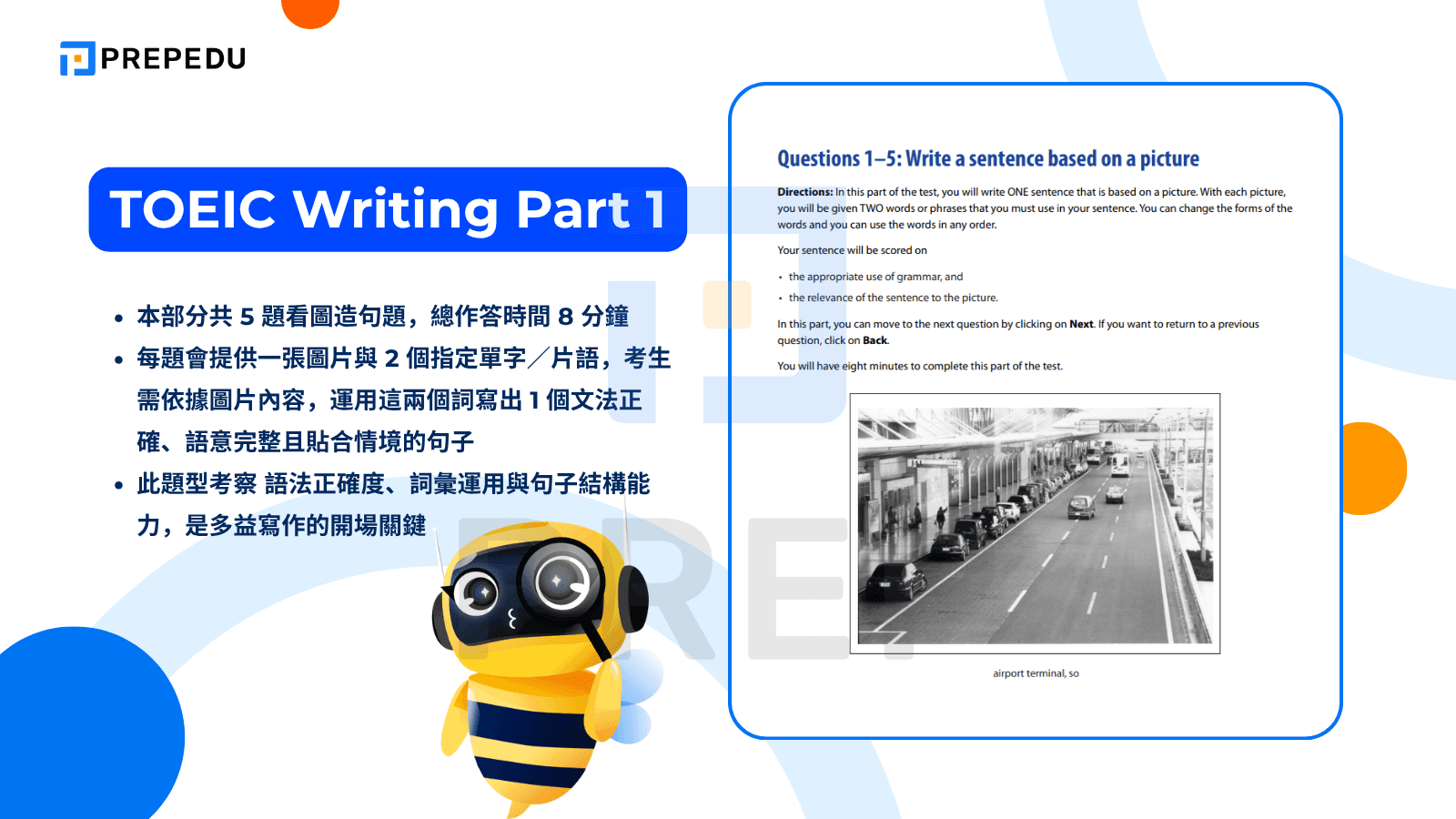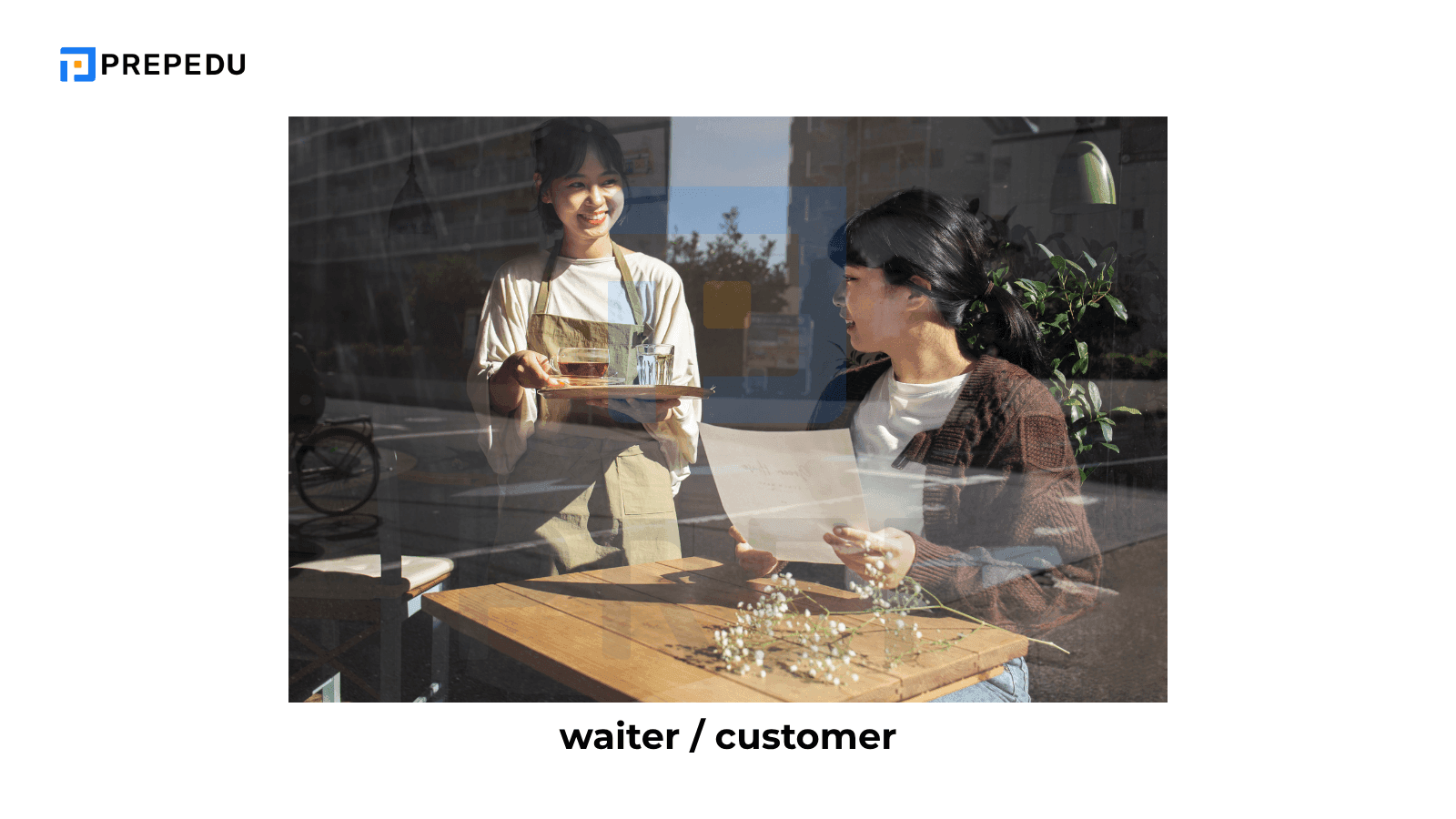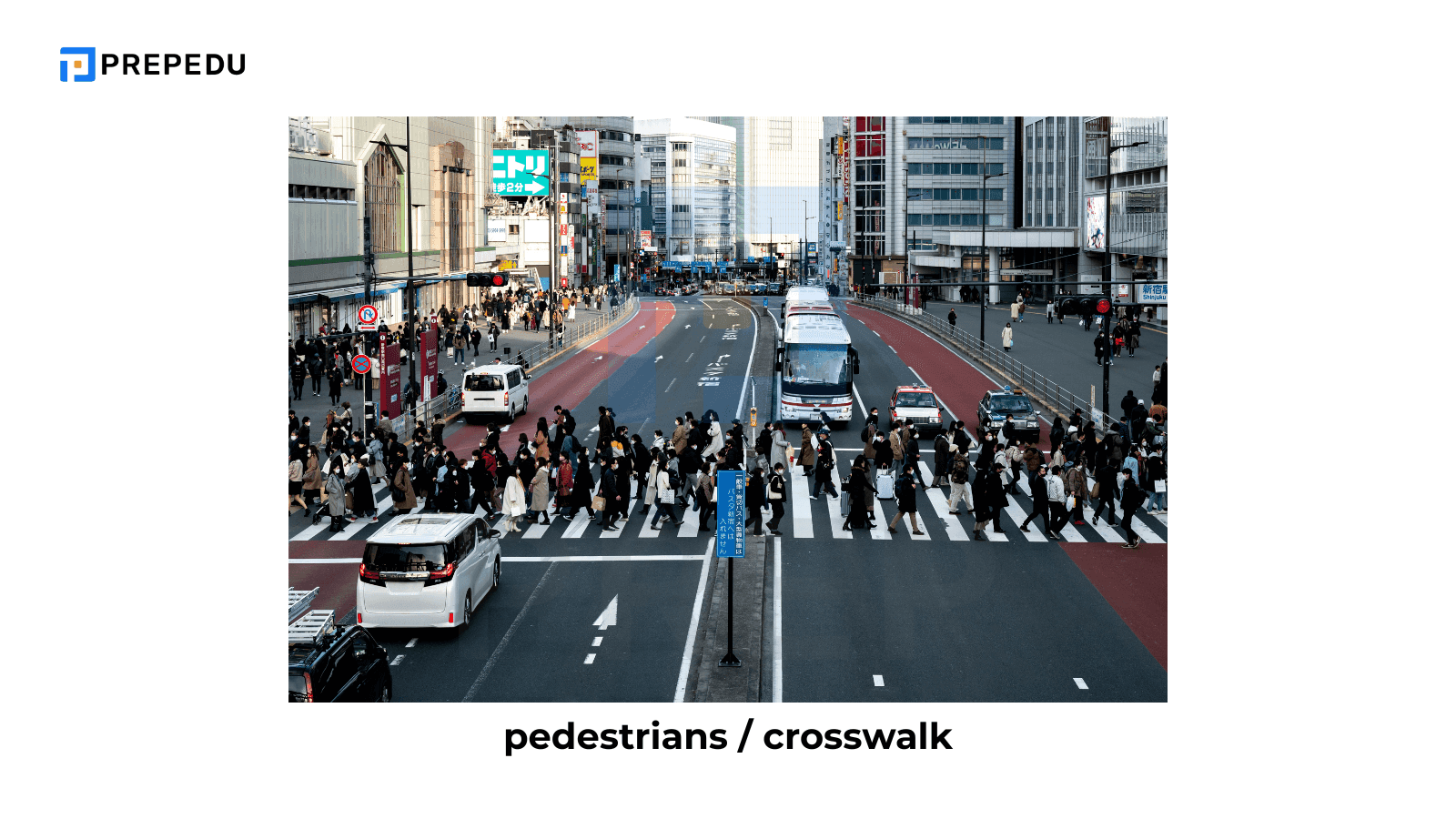掌握多益寫作 Part 1:看圖造句高分技巧 (TOEIC Writing Part 1 Write a sentence based on a picture)
如何在 TOEIC Writing Part 1 看圖造句題型中拿到滿分?這個問題困擾著無數準備多益寫作測驗的考生。其實,TOEIC Writing Part 1 要求考生根據圖片內容,使用兩個指定單字撰寫一個文法正確且切合畫面的完整句子,5 題總計 8 分鐘作答時間,每題最高可得 3 分。掌握正確的應試策略,你就能在這個看似簡單卻暗藏技巧的題型中輕鬆取得 15 分滿分。
許多考生誤以為看圖造句只是「把兩個單字塞進句子裡」就能過關,卻忽略了評分標準對文法正確性與圖片關聯性的嚴格要求。一個主詞動詞不一致的小錯誤、一個用錯的介系詞,都可能讓你的答案從 3 分降為 2 分。更關鍵的是,在平均每題僅 1.5 分鐘的時間壓力下,你需要快速分析圖片、精準運用指定單字、並選擇最合適的句型結構。
本文將系統性地拆解 TOEIC Writing Part 1 的三大核心策略:4W 圖片分析法、指定單字靈活運用技巧,以及五個黃金文法句型。透過真實考題範例解析、高頻場景詞彙整理,以及 PREPEDU 平台提供的 AI 即時回饋練習系統,你將學會如何在短時間內組織出高品質句子,讓評分者一眼看出你的英語實力,為整體寫作成績奠定穩固基礎。

I. 深入了解 TOEIC Writing Part 1:題型與評分標準解析
TOEIC Writing Part 1 是多益寫作測驗的開場題型,在整個寫作測驗中佔據第 1 至 5 題的位置。根據官方 ETS 測驗指引,這個部分共包含 5 題看圖造句題目,所有題目的總作答時間為 8 分鐘。
在每一題中,你會在螢幕上看到一張清晰的彩色照片,照片下方會提供兩個指定單字或詞組。你的任務是運用這兩個指定單字,撰寫一個 (ONE sentence) 與照片內容高度相關、文法結構正確的完整句子。
需要特別注意的是,TOEIC Writing Part 1 允許你改變指定單字的詞性形式,也可以按任何順序使用這些單字。舉例來說,如果給定的單字是 "walk" 和 "park",你可以寫:
-
A woman is walking in the park.(一位女子正在公園裡散步。):使用 walking 的進行
-
The park has many people who walk every morning.(這座公園每天早上都有許多人來散步。):調整單字順序
評分標準主要聚焦在兩個核心面向。首先是多益文法正確性 (Grammar),評分者會仔細檢查你的句子結構是否完整、時態使用是否恰當、主詞與動詞是否一致,以及冠詞、介系詞等細節是否運用得當。其次是與照片的關聯性 (Relevance to the picture),你的句子必須真實反映圖片中的人物、動作、物品及其相互關係,而非憑空想像或描述不存在的內容。

TOEIC Writing Part 1 採用 0 至 3 分的評分系統,每題最高可得 3 分。評分標準如下:
-
3 分 → 句子文法完全正確,包含兩個指定單字,內容與圖片高度相關且描述準確
-
2 分 → 句子包含兩個指定單字,但有 1 至 2 個小文法錯誤,或內容與圖片的關聯性不夠緊密
-
1 分 → 句子只包含一個指定單字,或有多個文法錯誤,或內容與圖片不相關
-
0 分 → 未作答或答案完全無法理解
關於作答時間,5 題總計 8 分鐘意味著平均每題約 1.5 分鐘。雖然系統不會限制單題作答時間,但妥善分配時間能確保你有充裕餘裕檢查答案,避免因時間不足而出現粗心錯誤。建議每題使用約 1 分鐘撰寫,保留 3 分鐘進行整體檢查。
請參考這裡的 TOEIC Writing 評分標準:多益口說寫作分數測驗完整解析:評分標準、分數計算與能力對照指南
II. 多益寫作 Part 1 高分關鍵:三大核心策略
要在 TOEIC Writing Part 1 取得理想成績,你需要掌握三個經過驗證的高分策略。這些策略不僅能提升答題速度,更能顯著提高句子品質,讓評分者一眼看出你的英語實力。無論你目前的英語程度如何,只要系統性地應用這三個策略,TOEIC Writing Part 1 的滿分目標絕對觸手可及。
1. 策略一:快速分析圖片,鎖定人、事、物、地
當圖片出現在螢幕上時,你應該立即啟動「4W 分析法」來拆解畫面元素。
-
Who(誰):
-
畫面中有誰?是一個人、多個人,還是沒有人物?
-
如果有多人,誰是主要人物?
-
-
What action(在做什麼):
-
他們正在進行什麼動作?是坐著、站著、交談、工作,還是做其他活動?
-
動作的狀態是正在進行、已完成,還是習慣性行為?
-
-
What objects(有哪些物品):注意周圍有哪些關鍵物品,如桌子、電腦、文件、食物、交通工具等。
-
Where(在哪裡):判斷場景可能是辦公室、餐廳、街道、公園或其他地點。
這個有系統的觀察流程能幫助你在 10 至 15 秒內建立清晰的畫面理解,為接下來的造句打下堅實基礎。透過這個方法,你不會遺漏圖片中的重要資訊,也能快速確定句子的主軸方向。特別要注意的是,TOEIC Writing Part 1 的圖片通常聚焦在職場、日常生活或商業情境,台灣和香港考生會發現許多場景都是熟悉的都市環境,例如辦公室會議、餐廳用餐、街道通勤等。善用你對這些場景的既有知識,能讓描述更加精準自然。
例如:

「4W 分析法」來分析這張圖片:
|
Who (誰) |
圖片中有一位男性,他是畫面中的主要人物。 |
|
What action (正在做什麼) |
他正在划動船槳,操縱一艘獨木舟前進。從濺起的水花可以看出,這個動作是正在進行的。 |
|
What objects (有哪些關鍵物品) |
|
|
Where (在哪裡) |
場景在一個水域上,根據圖片下方的文字提示以及平靜的水面,可以判斷這可能是一個湖泊 (lake) 或河流。 |
TOEIC Writing Part 1 範例句子:
-
A man is paddling a kayak on the water.(一名男子正在水上划獨木舟。)
-
A man wearing sunglasses is rowing a kayak.(一名戴著太陽眼鏡的男子正在划獨木舟。)
-
A man is competing in a kayak race on a lake.(一名男子正在湖上參加獨木舟比賽。)
2. 策略二:活用指定單字,構思完整句構
在分析完圖片後,你需要將注意力轉移到題目提供的兩個指定單字上。第一步是確認這兩個單字的詞性——它們可能是名詞、動詞、形容詞或介系詞。接著思考如何將這些單字自然地編織進你的句子架構中。記住,TOEIC Writing Part 1 明確允許你改變單字形式,所以動詞可以變成動名詞或分詞,名詞可以變成複數形式,這大大增加了你的表達彈性。
舉例來說,如果指定單字是 "meeting" 和 "colleague",你可以這樣運用:
-
使用原形:Several colleagues are attending a meeting in the conference room.(幾位同事正在會議室參加會議。)
-
改變形式:The woman is meeting her colleagues to discuss the project.(這位女士正在與同事會面討論專案。)
如果其中一個是動詞,它很可能成為句子的主要動詞;如果是名詞,它可能擔任主詞或受詞的角色。你應該圍繞這兩個指定單字來建構句子核心,而不是先寫完整個句子再強行塞入單字,那樣容易造成語意不順暢或文法錯誤。記住,指定單字是你的句子基石,其他元素都應該環繞它們來組織,這樣才能確保句子既符合題目要求,又流暢自然。
3. 策略三:掌握黃金文法句型,提升句子質感
熟練掌握幾個高頻實用的句型,能讓你在 TOEIC Writing Part 1 中如虎添翼。根據台灣和香港多益高分考生的經驗分享,以下五個句型在 Part 1 中的適用率超過 80%,值得你花時間熟練掌握。
|
句型結構 |
用途說明 |
範例 |
|
S + V + O + V-ing / p.p.(感官動詞/使役動詞句型) |
用來精準描述動態畫面,特別適合描寫人物正在進行的動作。 |
I can see a woman holding a coffee cup in the office.(我可以看到一位女士在辦公室裡拿著咖啡杯。) |
|
There is / are + N + V-ing / p.p.(描述存在的句型) |
用於客觀陳述圖片中的元素,避免主詞選擇的困擾。 |
There are several documents placed on the desk.(桌上放著幾份文件。) |
|
S + be + adj / adv + prep + N(描述狀態或位置的句型) |
用來清楚表達物品間的空間關係或人物的狀態。 |
The laptop is next to the coffee mug on the table.(筆記型電腦在桌上咖啡杯的旁邊。) |
|
S + V + O + to / for + N(描述目的或對象的句型) |
常用於描述服務業互動或工作場景。 |
The waiter is serving food to the customers.(服務生正在為顧客上菜。) |
|
S + who / that + V + V + O(使用關係子句增加描述細節) |
當你想在一個句子中包含更多資訊時特別實用。 |
The man who is wearing a suit is presenting the sales report.(穿著西裝的男士正在簡報銷售報告。) |
掌握這些句型後,你就擁有了靈活的工具箱,能夠應對 TOEIC Writing Part 1 各種場景的圖片描述需求。
III. 實戰演練:TOEIC Writing Part 1 Write a sentence based on a picture 範例與解析
透過實際範例練習,你能更具體理解如何將策略應用於真實考題。以下提供五組精心挑選的模擬試題,涵蓋 TOEIC Writing Part 1 常見的多益考試場景,每組範例都包含參考答案、中文翻譯和詳細解析。
1. 範例一:辦公室場景 (Office Scene)

|
✅ 3 分參考答案:
|
兩個答案都準確反映圖片內容,文法無誤,完全符合 3 分標準。 |
|
❌ 2 分範例: A woman is give presentation to her colleagues. |
➡️ 錯誤分析:動詞 "give" 應該改為 "giving"(現在進行式)或 "gives"(現在簡單式)。此外,"presentation" 前缺少冠詞 "a"。雖有文法錯誤,但語意仍可理解。 |
|
❌ 1 分範例: Woman presentation colleagues meeting. |
➡️ 錯誤分析:這個句子缺乏動詞,只是單字堆砌,不構成完整句子,會被評為 1 分或 0 分。 |
2. 範例二:餐廳場景 (Restaurant Scene)

|
✅ 3 分參考答案:
|
|
|
❌ 2 分範例:The waiter serve the customer at restaurant. |
➡️ 錯誤分析:動詞 "serve" 應該加上 -s 變成 "serves"(主詞是第三人稱單數)或使用進行式 "is serving"。另外 "restaurant" 前缺少冠詞 "the" 或 "a"。 |
3. 範例三:街道場景 (Street Scene)

|
✅ 3 分參考答案:
|
兩個答案都正確使用了 "pedestrians" 的複數形式,符合圖片中多人的情境。 |
4. 範例四:購物場景 (Shopping Scene)

|
✅ 3 分參考答案:
|
兩個答案都自然地整合了兩個指定單字,且都使用了複數形式 "tickets" 和 "machines",符合圖片內容。 |
5. 範例五:機場場景 (Airport Scene)

|
✅ 3 分參考答案:
|
|
IV. 考前必備:多益寫作 Part 1 常用單字與片語總整理
熟悉高頻出現的場景詞彙,能讓你在面對任何 TOEIC Writing Part 1 圖片時都胸有成竹。根據歷年考題分析,以下依據常見考題場景分類整理關鍵單字與片語,建議你將這些詞彙製作成隨身記憶卡片,每天複習 10 至 15 個。
1. 辦公室與會議場景
這類場景是 TOEIC Writing Part 1 最常見的考題類型,約佔所有題目的 30%。多益核心單字包括:
|
英文單字 |
意義 |
例句 |
|
英文名詞 |
||
|
presentation /priː.zenˈteɪ.ʃən/ |
簡報 |
The project leader delivered a persuasive presentation that secured funding from the investors for the next phase. (專案負責人發表了一場有說服力的簡報,為下一階段爭取到了投資者的資金。) |
|
document /dɑː.kjə.mənt/ |
文件 |
Before signing the contract, the lawyer advised her client to carefully read every clause in the document. (在簽署合約前,律師建議她的客戶仔細閱讀文件中的每一個條款。) |
|
laptop /læp.tɑːp/ |
筆記型電腦 |
A graphic designer is working on a new logo design on his laptop at a quiet coffee shop. (一位平面設計師正在一家安靜的咖啡店裡,用他的筆記型電腦設計新的標誌。) |
|
meeting /miː.t̬ɪŋ/ |
會議 |
The marketing team scheduled an urgent meeting to brainstorm ideas for the upcoming holiday campaign. (行銷團隊安排了一場緊急會議,為即將到來的節日活動集思廣益。) |
|
colleague /kɑː.liːɡ/ |
同事 |
After finishing the project, he went out for a celebratory dinner with his colleague who had been a great support. (完成專案後,他與一直以來大力支持他的同事外出享用慶功宴。) |
|
chart /tʃɑːrt/ |
圖表 |
The financial analyst is explaining the upward trend in sales by pointing to a specific line on the chart. (財務分析師正指著圖表上的一條特定線條,解釋銷售的上升趨勢。) |
|
screen /skriːn/ |
螢幕 |
The programmer stared intently at the computer screen, trying to find the single error in thousands of lines of code. (程式設計師專注地盯著電腦螢幕,試圖在數千行程式碼中找出那唯一的錯誤。) |
|
conference room /kɑːn.fɚ.əns ˌruːm/ |
會議室 |
The large conference room was being set up with extra chairs for the annual shareholder meeting. (為了年度股東大會,這間大型會議室正在佈置額外的椅子。) |
|
whiteboard /waɪt.bɔːrd/ |
白板 |
During the brainstorming session, ideas and diagrams completely covered the whiteboard from corner to corner. (在腦力激盪會議中,想法和圖表完全覆蓋了白板的每一個角落。) |
|
projector /prəˈdʒek.tɚ/ |
投影機 |
The IT support staff is adjusting the focus of the projector so the presentation slides are clear for everyone in the room. (資訊技術支援人員正在調整投影機的焦距,以便會議室裡的每個人都能看清楚簡報。) |
|
desk /desk/ |
辦公桌 |
Her desk is always neatly organized with a planner, a pen holder, and a small plant to brighten her workspace. (她的辦公桌總是整理得井井有條,上面有一個行事曆、一個筆筒和一株為工作空間增添生氣的小盆栽。) |
|
office /ˈɑː.fɪs/ |
辦公室 |
The company is moving to a new office downtown that offers a better view and more collaborative spaces. (公司正搬往市中心一間新辦公室,那裡有更好的景觀和更多的協作空間。) |
|
report /rɪˈpɔːrt/ |
報告 |
He needs to finish writing the quarterly sales report before the deadline at the end of the day. (他必須在今天下班的截止日期前,完成撰寫季度銷售報告。) |
|
computer /kəmˈpjuː.t̬ɚ/ |
電腦 |
An employee is restarting her computer because a software application has stopped responding. (一位員工正在重新啟動她的電腦,因為一個應用程式停止回應了。) |
|
動詞與動詞片語 |
||
|
discussing /dɪˈskʌs.ɪŋ/ |
討論 |
The architects are discussing the blueprints for the new library, focusing on sustainability and natural light. (建築師們正在討論新圖書館的藍圖,重點關注永續性和自然採光。) |
|
presenting /prɪˈzen.tɪŋ/ |
簡報 |
A scientist is presenting her research findings on climate change to an audience of international experts. (一位科學家正在向國際專家們簡報她關於氣候變遷的研究成果。) |
|
typing /ˈtaɪ.pɪŋ/ |
打字 |
The journalist is quickly typing an article on his laptop to meet the press deadline for the morning news. (那位記者正在筆電上快速打字撰寫一篇文章,以趕上早報的截稿時間。) |
|
reviewing /rɪˈvjuː.ɪŋ/ |
檢閱 |
The editor is carefully reviewing the manuscript for any grammatical errors before it goes to print. (編輯正在仔細檢閱手稿,檢查是否有任何文法錯誤,然後才送去印刷。) |
|
pointing at /ˈpɔɪn.tɪŋ æt/ |
指著 |
The tour guide is pointing at a historical landmark on the map while explaining its significance to the tourists. (導遊正指著地圖上的一個歷史地標,同時向遊客解釋其重要性。) |
|
working on /ˈwɝː.kɪŋ ɑːn/ |
從事 |
The mechanic is working on the engine of a vintage car, carefully restoring it to its original condition. (那位技工正在維修一輛古董車的引擎,小心翼翼地將其恢復到原始狀態。) |
|
attending /əˈten.dɪŋ/ |
參加 |
The sales team is attending a three-day training workshop to learn about new customer relationship strategies. (銷售團隊正在參加一個為期三天的培訓工作坊,學習新的客戶關係策略。) |
|
conducting /kənˈdʌk.tɪŋ/ |
進行 |
A manager is conducting a performance review with an employee in her private office. (一位經理正在她的私人辦公室裡,與一名員工進行績效評估。) |
|
organizing /ˈɔːr.ɡə.naɪ.zɪŋ/ |
組織 |
The event planner is organizing files into different folders to keep track of vendors for the upcoming wedding. (活動策劃師正在將文件整理到不同的文件夾中,以追蹤即將舉行的婚禮的各家廠商。) |
|
preparing /prɪˈper.ɪŋ/ |
準備 |
The chef is meticulously preparing the ingredients for the evening's special tasting menu. (主廚正在一絲不苟地為晚上的特別品嚐菜單準備食材。) |
2. 餐廳與商店場景
|
英文單字 |
意義 |
例句 |
|
名詞 |
||
|
customer /kʌs.tə.mɚ/ |
顧客 |
A customer is asking the shop assistant for help to find a book from the top shelf. (一位顧客正在請店員幫忙,以便從最上層的架子上找到一本書。) |
|
waiter/waitress /weɪ.t̬ɚ/ /ˈweɪ.trəs/ |
服務生 |
The waiter is gracefully pouring wine into a glass for a couple celebrating their anniversary. (服務生正優雅地為一對慶祝週年紀念日的夫婦將酒倒入杯中。) |
|
menu /men.juː/ |
菜單 |
Two friends are looking at the dessert menu, trying to decide between the chocolate cake and the crème brûlée. (兩位朋友正在看甜點菜單,試圖在巧克力蛋糕和法式烤布蕾之間做出選擇。) |
|
counter /kaʊn.tɚ/ |
櫃台 |
The baker is arranging freshly baked croissants on a tray behind the bakery counter. (麵包師傅正在麵包店的櫃台後方,將剛出爐的可頌麵包擺放到托盤上。) |
|
display /dɪˈspleɪ/ |
陳列 |
The jewelry store's window display features a stunning diamond necklace under a spotlight. (珠寶店的櫥窗陳列在聚光燈下展示了一條璀璨的鑽石項鍊。) |
|
shelf /ʃelf/ |
架子 |
A librarian is carefully placing books back onto the correct shelf in the history section. (一位圖書館員正小心翼翼地將書放回歷史區的正確書架上。) |
|
cashier /kæˈʃɪr/ |
收銀員 |
The cashier is smiling while handing a receipt and the change to a customer at the grocery store. (在雜貨店裡,收銀員微笑著將收據和零錢遞給一位顧客。) |
|
shopping cart /ʃɑː.pɪŋ ˌkɑːrt/ |
購物車 |
A father is pushing a shopping cart down the aisle while his young son points at his favorite cereal box. (一位父親正推著購物車走在走道上,而他年幼的兒子指著他最喜歡的麥片盒。) |
|
receipt /rɪˈsiːt/ |
收據 |
The man is checking his receipt to make sure he was charged correctly for all the items he bought. (那位男子正在核對他的收據,以確保他購買的所有商品都計價正確。) |
|
table /teɪ.bəl/ |
桌子 |
A family is gathered around a large wooden table in their dining room, sharing a holiday meal. (一個家庭正圍坐在他們餐廳的一張大木桌旁,共享節日大餐。) |
|
restaurant /res.tə.rɑːnt/ |
餐廳 |
The new restaurant downtown is famous for its authentic Italian pasta and cozy atmosphere. (市中心那家新餐廳以其道地的義大利麵和舒適的氛圍而聞名。) |
|
food /fuːd/ |
食物 |
A street vendor is preparing delicious-looking food on a grill for a long line of hungry people. (一位街頭小販正在烤架上為大排長龍的飢餓人群準備看起來很美味的食物。) |
|
store /stɔːr/ |
商店 |
A woman is looking through the window of a clothing store, admiring the new collection on the mannequins. (一位女士正透過一家服飾店的櫥窗,欣賞著模特兒身上展示的新系列。) |
|
product /prɑː.dʌkt/ |
產品 |
A marketing manager is examining the packaging of a new product to ensure it is attractive to consumers. (一位行銷經理正在檢查一項新產品的包裝,以確保它對消費者有吸引力。) |
|
動詞與動詞片語 |
||
|
serving /sɝː.vɪŋ/ |
提供服務 |
A flight attendant is serving beverages to passengers from a trolley in the airplane aisle. (一位空服員正在飛機走道上,用手推車為乘客提供飲料服務。) |
|
ordering /ɔːr.dɚ.ɪŋ/ |
點餐 |
A man is ordering a coffee and a pastry by pointing to the items in the display case. (一位男士正指著展示櫃裡的品項,點了一杯咖啡和一份糕點。) |
|
paying /peɪ.ɪŋ/ |
付款 |
A customer is paying for her groceries using the contactless payment feature on her smartphone. (一位顧客正在用她智慧型手機上的感應支付功能來付帳。) |
|
browsing /braʊ.zɪŋ/ |
瀏覽 |
A teenager is browsing through a rack of vintage jackets at a second-hand clothing store. (一位青少年正在一家二手服飾店裡,瀏覽一架子的復古夾克。) |
|
selecting /səˈlek.tɪŋ/ |
挑選 |
A man is carefully selecting fresh vegetables from a stall at the farmer's market. (一位男士正在農夫市集的一個攤位上,仔細挑選新鮮的蔬菜。) |
|
carrying /ker.i.ɪŋ/ |
攜帶 |
A student is carrying a heavy stack of textbooks from the library back to her dormitory. (一位學生正從圖書館抱著一疊沉重的教科書走回她的宿舍。) |
|
purchasing /pɝː.tʃəs.ɪŋ/ |
購買 |
The couple is purchasing tickets online for a concert they have been wanting to see for months. (那對情侶正在線上購買他們期待了幾個月的演唱會門票。) |
|
eating /iː.t̬ɪŋ/ |
用餐 |
A group of friends is eating pizza and laughing together at an outdoor patio table. (一群朋友正在一個戶外露台的桌子旁,一起吃著披薩、開心地笑著。) |
|
drinking /drɪŋ.kɪŋ/ |
喝 |
A woman is sitting on a park bench and drinking from a reusable water bottle after her morning run. (一位女士在晨跑後,正坐在公園的長椅上,用可重複使用的水瓶喝水。) |
|
choosing /tʃuː.zɪŋ/ |
選擇 |
A little girl is taking a long time choosing an ice cream flavor from the many options available. (一個小女孩正花很長時間,從眾多選項中選擇一種冰淇淋口味。) |
3. 戶外與交通場景
|
英文單字 |
意義 |
例句 |
|
名詞 |
||
|
pedestrian /pəˈdes.tri.ən/ |
行人 |
A pedestrian is waiting for the signal to change before he crosses the busy intersection. (一位行人正在等待號誌變換,然後才要穿越這個繁忙的十字路口。) |
|
vehicle /viː.ə.kəl/ |
車輛 |
A delivery vehicle is parked on the side of the road with its hazard lights flashing. (一輛送貨車輛停在路邊,閃爍著警示燈。) |
|
sidewalk /saɪd.wɑːk/ |
人行道 |
A child is learning to ride a scooter on the sidewalk while his mother watches him closely. (一個孩子正在人行道上學騎滑板車,而他的媽媽在一旁密切關注著。) |
|
traffic /træf.ɪk/ |
交通 |
Due to an accident, the morning traffic on the highway is moving much slower than usual. (由於一場意外,高速公路早晨的交通比平時緩慢得多。) |
|
construction /kənˈstrʌk.ʃən/ |
施工 |
The city is undergoing major construction to build a new subway line, causing some street closures. (這個城市正在進行建造新地鐵線的大型施工,導致部分街道封閉。) |
|
park /pɑːrk/ |
公園 |
Many people are having a picnic in the park to enjoy the sunny weather on the weekend. (許多人正在公園裡野餐,享受週末陽光明媚的好天氣。) |
|
crosswalk /krɑːs.wɑːk/ |
斑馬線 |
A group of schoolchildren is using the crosswalk to get to the other side of the street, led by their teacher. (一群學童在老師的帶領下,正利用斑馬線走到街的對面。) |
|
bus stop /bʌs ˌstɑːp/ |
公車站 |
Several people are queuing patiently at the bus stop during the evening rush hour. (在傍晚的尖峰時段,有幾個人正在公車站耐心排隊。) |
|
bicycle /baɪ.sə.kəl/ |
腳踏車 |
A man has chained his bicycle to a rack outside the library before going inside. (一位男子在進入圖書館前,將他的腳踏車鎖在館外的架子上。) |
|
street /striːt/ |
街道 |
The street is beautifully decorated with colorful lanterns for the annual cultural festival. (為了年度文化節,街道被裝飾上五彩繽紛的燈籠,非常漂亮。) |
|
building /bɪl.dɪŋ/ |
建築物 |
The historic building with its intricate facade is a popular attraction for tourists and architects alike. (那座擁有複雜立面的歷史建築,是吸引遊客和建築師的熱門景點。) |
|
road /roʊd/ |
道路 |
The winding road through the mountains offers breathtaking views of the valley below. (那條蜿蜒穿過山區的道路,可以欣賞到下方山谷令人屏息的美景。) |
|
station /steɪ.ʃən/ |
車站 |
A traveler is checking the departure board at the train station to find her platform number. (一位旅客正在火車站查看出發資訊看板,尋找她的月台號碼。) |
|
airport /er.pɔːrt/ |
機場 |
Passengers are going through the security check at the airport before heading to their boarding gates. (在前往登機門之前,乘客們正在機場通過安全檢查。) |
|
動詞與動詞片語 |
||
|
crossing /krɑː.sɪŋ/ |
穿越 |
A woman is crossing a wooden bridge over a small stream in the countryside. (一位女士正在鄉間穿越一座橫跨小溪的木橋。) |
|
waiting for /weɪ.t̬ɪŋ fɔːr/ |
等待 |
The dog is eagerly waiting for its owner to throw the ball in the backyard. (那隻狗正在後院裡,熱切地等待牠的主人把球丟出去。) |
|
riding /raɪ.dɪŋ/ |
騎乘 |
A man is riding a horse along a scenic trail on the beach during sunset. (一位男士正趁著日落時分,在風景優美的海灘小徑上騎馬。) |
|
walking along /wɑː.kɪŋ əˈlɑːŋ/ |
沿著走 |
A couple is walking along the riverbank, enjoying a peaceful afternoon stroll. (一對情侶正沿著河岸散步,享受著寧靜的午後時光。) |
|
standing at /stæn.dɪŋ æt/ |
站在 |
A man is standing at the edge of a cliff, looking out at the vast ocean before him. (一位男士正站在懸崖邊,眺望著他面前廣闊的海洋。) |
|
driving /draɪ.vɪŋ/ |
駕駛 |
She is carefully driving her car through a narrow street in an old European city. (她正小心翼翼地駕駛著她的車,穿過一個古老歐洲城市的狹窄街道。) |
|
traveling /træv.əl.ɪŋ/ |
旅行 |
A young backpacker is traveling by train through Southeast Asia to experience different cultures. (一位年輕的背包客正搭乘火車穿越東南亞旅行,體驗不同的文化。) |
|
commuting /kəˈmjuː.tɪŋ/ |
通勤 |
Many people are commuting to work by ferry to avoid the heavy city traffic. (許多人搭乘渡輪通勤上班,以避開擁擠的城市交通。) |
|
passing by /pæs.ɪŋ baɪ/ |
經過 |
The parade is passing by the town square, where a large crowd has gathered to watch. (遊行隊伍正在經過市鎮廣場,那裡聚集了大量觀看的群眾。) |
4. 描述動作與狀態常用動詞
|
英文單字 |
意義 |
例句 |
|
基本動作動詞 |
||
|
pointing at /pɔɪn.tɪŋ æt/ |
指著 |
A museum curator is pointing at the fine details of a 17th-century painting while explaining its history. (一位博物館館長正指著一幅十七世紀畫作的精緻細節,同時解說其歷史。) |
|
looking at /lʊk.ɪŋ æt/ |
看著 |
An art student is looking at a sculpture in the gallery, sketching its form in his notebook. (一位藝術系的學生正在美術館裡看著一座雕塑,並在他的筆記本上素描其形狀。) |
|
holding /hoʊl.dɪŋ/ |
握著/拿著 |
A groom is gently holding his bride's hand as they walk down the aisle after the ceremony. (在儀式結束後,一位新郎正溫柔地牽著新娘的手走下紅毯。) |
|
wearing /wer.ɪŋ/ |
穿著/戴著 |
A businessman is wearing a well-tailored suit and a tie for an important client meeting. (一位商務人士正穿著一套剪裁合身的西裝、打著領帶,準備參加一個重要的客戶會議。) |
|
sitting /sɪt̬.ɪŋ/ |
坐著 |
An elderly woman is sitting on a rocking chair on her porch, reading a novel in the afternoon sun. (一位年長的女士正坐在她門廊的搖椅上,在午後的陽光下閱讀一本小說。) |
|
standing /stæn.dɪŋ/ |
站著 |
A security guard is standing by the entrance of the bank, observing the people coming in and out. (一位保全警衛正站在銀行的入口旁,觀察著進出的人群。) |
|
walking /wɑː.kɪŋ/ |
走路 |
A man is walking his dog on a leash through a park covered in autumn leaves. (一位男士正牽著他的狗,走過一個鋪滿秋葉的公園。) |
|
running /rʌn.ɪŋ/ |
跑步 |
A group of athletes is running on a track, training for an upcoming marathon. (一群運動員正在跑道上跑步,為即將到來的馬拉松進行訓練。) |
|
talking /tɑː.kɪŋ/ |
交談 |
Two colleagues are talking near the water cooler, taking a short break from their work. (兩位同事正在飲水機旁交談,從工作中稍作休息。) |
|
listening /lɪs.ən.ɪŋ/ |
聆聽 |
A student is attentively listening to a podcast with headphones on while commuting on the subway. (一位學生在搭地鐵通勤時,正戴著耳機專注地聆聽一個播客節目。) |
|
進階動作動詞 |
||
|
arranging /əˈreɪn.dʒɪŋ/ |
整理/安排 |
A librarian is arranging books on a cart in alphabetical order before placing them back on the shelves. (一位圖書館員正在將手推車上的書按照字母順序整理好,然後才把它們放回書架上。) |
|
carrying /ker.i.ɪŋ/ |
提著/搬著 |
A construction worker is carrying a heavy toolbox as he walks across the building site. (一位建築工人正提著一個沉重的工具箱,走過建築工地。) |
|
placing /pleɪ.sɪŋ/ |
放置 |
A mother is gently placing a blanket over her sleeping child in the crib. (一位母親正輕柔地將一條毯子蓋在嬰兒床裡熟睡的孩子身上。) |
|
examining /ɪɡˈzæm.ɪ.nɪŋ/ |
檢查 |
A watchmaker is examining the intricate gears of a mechanical watch using a special magnifying glass. (一位鐘錶匠正在使用特殊的放大鏡,檢查一只機械錶內部複雜的齒輪。) |
|
reaching for /riː.tʃɪŋ fɔːr/ |
伸手拿 |
A child is on his father's shoulders, reaching for an apple from a high branch of the tree. (一個孩子正坐在他父親的肩膀上,伸手去摘樹上高處的一顆蘋果。) |
|
leaning against /liː.nɪŋ əˈɡenst/ |
靠著 |
A tired traveler is leaning against his large backpack while waiting for his train to arrive. (一位疲憊的旅客正靠著他的大背包,等待他要搭的火車到站。) |
|
preparing /prɪˈper.ɪŋ/ |
準備 |
A pharmacist is carefully preparing a prescription by measuring the correct amount of medication. (一位藥劑師正透過測量正確的藥量,小心地準備處方藥。) |
|
operating /ɑː.pə.reɪ.t̬ɪŋ/ |
操作 |
A factory worker is operating a large piece of machinery by pressing buttons on a control panel. (一位工廠工人正在透過控制面板上的按鈕,操作一台大型機器。) |
|
assembling /əˈsem.blɪŋ/ |
組裝 |
A technician is assembling the different components of a new computer on an anti-static mat. (一位技術人員正在一張抗靜電墊上,組裝一台新電腦的各種零件。) |
|
demonstrating /dem.ən.streɪ.tɪŋ/ |
示範 |
A fitness instructor is demonstrating the correct form for a yoga pose to her class. (一位健身教練正在向她的學員們示範一個瑜珈姿勢的正確體式。) |
|
狀態描述 |
||
|
busy /bɪz.i/ |
忙碌的 |
The street market is very busy, with vendors shouting and customers bargaining for goods. (這個街頭市集非常忙碌,小販們叫賣著,顧客們則為商品討價還價。) |
|
focused /foʊ.kəst/ |
專注的 |
The chess player is completely focused on the board, planning his next several moves. (那位棋手完全專注於棋盤,計畫著他接下來的幾步棋。) |
|
happy /hæp.i/ |
快樂的 |
The children look happy as they fly kites in a wide-open field on a windy day. (在一片開闊的田野上,孩子們在有風的日子裡放著風箏,看起來很快樂。) |
|
crowded /kraʊ.dɪd/ |
擁擠的 |
The concert hall is crowded with fans who are excited to see their favorite band perform. (音樂廳裡擠滿了粉絲,他們興奮地期待著見到自己最愛的樂團表演。) |
|
empty /emp.ti/ |
空的 |
After the last class of the day, the university lecture hall is completely empty and quiet. (在一天最後一堂課結束後,大學的演講廳變得完全空蕩且安靜。) |
|
full /fʊl/ |
滿的 |
The parking lot is full, so drivers are circling around, looking for a space. (停車場已經滿了,所以駕駛們正在繞圈尋找車位。) |
|
organized /ɔːr.ɡə.naɪzd/ |
有條理的 |
The mechanic's tools are all organized neatly on a pegboard wall so he can find them easily. (技工的工具都有條理地整齊掛在洞洞牆上,這樣他就能輕易找到。) |
|
clean /kliːn/ |
乾淨的 |
The hotel room is very clean, with fresh towels and perfectly made beds. (這間飯店房間非常乾淨,有著清新的毛巾和整理完美的床鋪。) |
5. 進階技巧:介系詞和方位詞的運用
|
英文單字 |
意義 |
例句 |
|
位置介系詞 |
||
|
on /ɑːn/ |
在...上 |
The cat is sleeping peacefully on the soft cushion of the windowsill. (那隻貓正安詳地睡在窗台的軟墊上。) |
|
in /ɪn/ |
在...裡 |
There are several colorful pens in the organizer on the office desk. (辦公桌上的收納盒裡有好幾支彩色的筆。) |
|
at /æt/ |
在...處 |
The family is having dinner at a round table in the corner of the restaurant. (這家人正在餐廳角落的一張圓桌處享用晚餐。) |
|
next to /nekst tu/ |
在...旁邊 |
A small lamp is placed next to the bed on the nightstand for late-night reading. (一盞小檯燈被放在床頭櫃上、床的旁邊,以供深夜閱讀。) |
|
behind /bɪˈhaɪnd/ |
在...後面 |
A young boy is hiding behind a large tree during a game of hide-and-seek. (在玩捉迷藏時,一個小男孩正躲在一棵大樹的後面。) |
|
in front of /ɪn ˈfrʌnt əv/ |
在...前面 |
A speaker is standing in front of a podium, addressing a large audience. (一位演講者正站在講台前面,向廣大的聽眾發表演說。) |
|
between /bɪˈtwiːn/ |
在...之間 |
The bicycle path runs between the river and a row of beautiful cherry blossom trees. (自行車道延伸在河流與一排美麗的櫻花樹之間。) |
|
near /nɪr/ |
靠近 |
A coffee shop is located near the main entrance of the train station. (火車站主要入口的附近有一家咖啡店。) |
|
across from /əˈkrɑːs frʌm/ |
在...對面 |
The public library is situated across from the city hall on the main street. (公共圖書館位於主要街道上,就在市政廳的對面。) |
|
方位詞 |
||
|
left /left/ |
左邊 |
On the left side of the road, there is a park with a children's playground. (在路的左邊,有一個附設兒童遊樂場的公園。) |
|
right /raɪt/ |
右邊 |
The entrance to the museum is on the right, just past the large fountain. (博物館的入口在右邊,過了那個大噴水池就是。) |
|
center /sen.t̬ɚ/ |
中央 |
In the center of the room, there is a large, ornate rug that ties all the furniture together. (在房間的中央,有一張華麗的大地毯,將所有家具連結在一起。) |
|
top /tɑːp/ |
頂部 |
A flag is waving from the top of the tallest building in the city. (一面旗幟正在城市最高建築物的頂部飄揚。) |
|
bottom /bɑː.t̬əm/ |
底部 |
The artist's signature is located at the bottom right corner of the painting. (畫家的簽名位於畫作的右下角底部。) |
|
middle /mɪd.əl/ |
中間 |
A man in a blue shirt is standing in the middle of the group photo. (一位穿著藍色襯衫的男士正站在團體照的中間。) |
|
corner /kɔːr.nɚ/ |
角落 |
A comfortable armchair is placed in the corner of the living room, creating a cozy reading nook. (一張舒適的扶手椅被放置在客廳的角落,營造出一個溫馨的閱讀角落。) |
看更多文章:
結論
TOEIC Writing Part 1 雖然是寫作測驗中最基礎的題型,但它是展現你英語基本功的重要舞台。透過掌握系統化的圖片分析方法、熟練運用指定單字的形式變化、以及靈活套用五大黃金文法句型,你完全有能力在這個部分取得滿分 15 分(5 題 × 3 分)。記住,多益寫作能力的提升需要持續練習,建議你每天至少完成 3 至 5 題看圖造句練習,並請英語能力較強的朋友或老師幫你批改,指出文法盲點。

你好!我叫黃秋賢。現在在網站 prepedu.com 的部落格擔任產品內容經理。
我有超過5年的英語、韓語等外語自學經驗,並準備過 IELTS、TOEIC、TOPIK 等考試,累積了豐富的實戰知識,也曾協助數千位在語言學習上遇到困難的人。希望以上的分享能幫助大家在家中更有效率地自學!
評論











